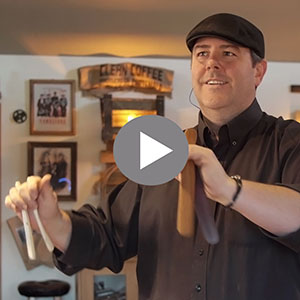
Rhythm Bones are one of the earliest rhythm instruments in human history. The instrument has roots in China, ancient Mesopotamia, Egypt, Greece, Rome, across Europe to England, and the United States. The Online Museum has a wealth of historical information.
Rhythm bones are sourced from animal (bones), vegetable (wood) and mineral materials. Each material offers a different tonality to the player, and some people like to mix and match materials. Go to the Make or Buy Rhythm Bones page to help decide which path to take.
The tone is also affected by the placement of the instrument in the hand. To hear how different materials sound, go to Listen to the Sounds They Make below on this page.
Typically rhythm bones are somewhere between 4 and 8 inches in length, and curved so as to fit in the hand, usually with convex surfaces towards each other. There are various methods of playing rhythm bones, but in most cases one bone is fixed in place against the palm while the other bone is free to move back and forth mostly using arm motions. Go to Learn How to Play Them for a wealth of instruction resources.
The American style typically involves playing a set of bones with both hands allowing syncopated beats and greater tonal variety. Irish rhythm bones playing tends to be one-handed and comparatively understated. Three or four bones in each hand can also be played.
Rhythm bones are an extension of the body, and can be played in a minimalist fashion (close to the chest), or more energetically (with bigger arm and body motions). Each player develops their own unique style of playing. As with any instrument, it takes time and dedication to play rhythm bones well.
Come to a Bones Fest where attendees share techniques, workshops teach techniques, and we get a chance to perform with great backup music. There is a Bones Marketplace where you try out rhythm bones for sale and decide which kind you like. Below are characteristics of the most popular types.
Animal Rib Bone

Animal rhythm bone made from a cow rib. They are made from many animal ribs including bison, ox, goat and more. Rib bones have bone marrow inside which produces a complex tone. It is from this type of bone that Rhythm Bones got its name.
Animal Shin Bone

Animal shin rhythm bone made from the shin of a cow. A shin bone is sort of square and can be cut to make four rhythm bones. Because this is a solid bone it has a purer tone than the rib bone.
Wood Rhythm Bone

Shown above is a Wood example with this being a Danforth rhythm bone. It is shaped like a rib bone and made from maple wood. They are made from most any type of wood with hardwood like rosewood and mahogany producing crisper and louder sounds while softwoods like pine and ceder producing quieter sounds. Ebony has rich tone. Being wood the shape can be controlled to produce unique tones.
Example of Mineral Bone

Shown above is a mineral rhythm bone made out of plastic, and it makes a quiet sound. Another popular material is aluminum which sounds better than you think is would. Shape and other properties can be controlled such as the heavier bottom shown above to produce unique tones.
Michael Baxter produced a breakthrough video demonstrating the sound of many kinds of rhythm bones. It’s purpose is to make it easier to decide which type of rhythm bones to Make or Buy. Scott Miller did that but in several individual videos on his Dry Bones website, and here Michael Baxter does it in one video. This is a much needed addition to our website. Thanks, Michael. Click Mike’s image to view.

